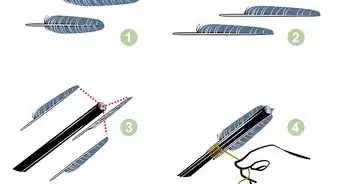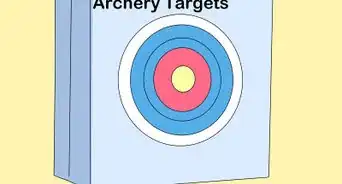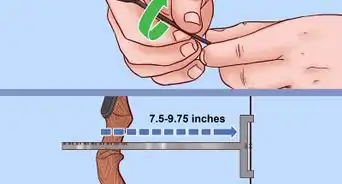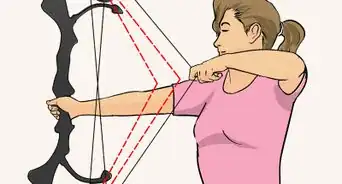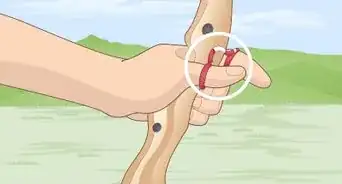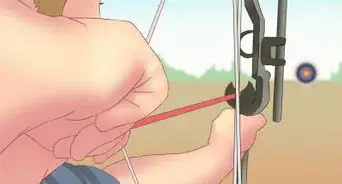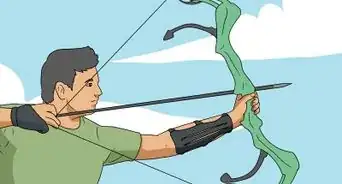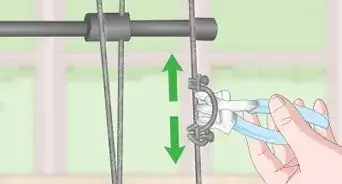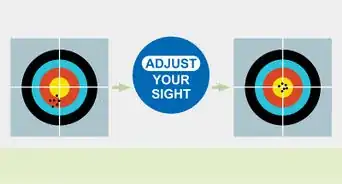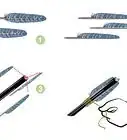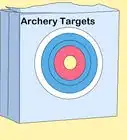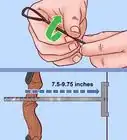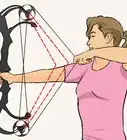wikiHow is a “wiki,” similar to Wikipedia, which means that many of our articles are co-written by multiple authors. To create this article, 10 people, some anonymous, worked to edit and improve it over time.
This article has been viewed 286,277 times.
Learn more...
A compound bow is an advanced type of bow that uses pulleys and stiff limbs, rather than bent limbs, to produce adequate force to shoot an arrow. More accurate than traditional bows, compound bows are also more complicated instruments and require expertise and skill to properly maintain. The steps below will guide you through the basic procedure of restringing a bow, but they are not a replacement for experienced supervision if you have never restrung a particular model before. Improper restringing attempts can result in serious injury, as well as damage to your bow.
Steps
Using a Bow Press
-
1Check the old bow string for any irregularities. If the old string has serious faults, it could break during removal and cause serious injury. If the string is severely worn, consider bringing the bow to a professional for restringing.
-
2Select and wax a new bow string. Consult your bow's manufacturer or packaging information to find out whether the use of certain strings will void your warranty.[1] Once you know which strings are safe, you can select from a variety of synthetic materials with different attributes, including Dacron, Vectran, and Dyneema. Even a slight glitch can make the restringing process dangerous and unsuccessful, so discard any string with bumps, cracks, or other irregularities. Rub bow wax over the string before continuing to make it easier to attach and use.
- Note: Be sure to purchase a bow string, not a bow cable. Bow cables are intended for operating pulleys and applying additional pressure to the bow limbs, not for shooting arrows.
-
3Choose a double pull compound bow press that is safe for your bow. Many compound bows cannot be safely strung without a specialized "bow press" to hold the bow in place and bend the limbs in the appropriate position. Consult a professional or your bow's manufacturer to confirm what size and type of bow press is safe for your bow, as they come in many different forms.
- Modern "double-pull" presses that pull the riser, or center portion of the bow, in two locations are much less likely to damage the bow than "single-pull" style presses.
- If your bow has past-parallel limbs, which have a more significant outward curve, you will need a specialized bow press.[2]
-
4Place the bow into the bow press. If you are not familiar with a particular model of bow press, finding experienced supervision is highly recommended to avoid injury to yourself or the bow. Most bow presses require you to loosen the weight-adjustment bolts on each limb by five to seven turns first, but beyond that they can vary greatly. A bow press may have restraining arms that lock over the bow, bolts that tighten your bow's limbs in place, a series of locks over the limbs and handgrips, or some combination of the above.[3]
- Note: Always loosen your compound bow by alternating limbs with each turn. If you loosen one limb by several turns before you have begun to loosen other limb, you risk breaking your bow or causing an accident due to the unequal pressure.
-
5Determine whether to remove the old string first. Bows with a "teardrop' attachment point, which has two grooves for slipping on a string, should be stringed while the old string is in place. Bows without this attachment should have the old string removed before the new one is attached, unhooking the string from each cam or idle wheel at the end of each limb.
- Ask an experienced archer if you cannot identify a possible teardrop attachment.
-
6For non-teardrop systems, thread the new string starting with a cam. Attach the end loop to the appropriate post in the center of a cam. Loop the string under the cam and back over, slotting it into the groove. If your bow has two cams, perform the same action in reverse on the other cam. If it is a single-cam bow, loop the string around the idler wheel on the other limb, then back down to attach the other end to the cam.
- If your bow has a single cam with a post on either side, attach the first end loop to the post on the side of the bow with the sight window.
-
7For teardrop systems, thread the new string's loops onto the empty grooves of the teardrop. Attach the first end loop of the new string over the empty groove on one side of the teardrop. Do the same with the end loop and teardrop near the other limb, making sure both loops remain firmly seated. You may now remove the old string from the other side of the teardrop.
-
8Re-tighten the bow and slowly remove it from the bow press. Tighten the bolts to their original setting, alternating by turning one and then the other. Slowly release the bow from the bow press, watching to make sure the string remains properly seated in the correct grooves. If there is any sign that the string is not correctly seated, stop, fasten the bow press again, and adjust the string.
Re-stringing a Teardrop Bow by Hand
-
1Identify whether your bow can be restrung by hand. The only compound bows that can be restrung by hand are older models with a "teardrop" shaped attachment for the string. These attachment points have two grooves in order to hold two strings at once, allowing you to use the old string to keep the bow in position while you attach the new one. Many of these can still be placed in a bow press for safer stringing.[4] No compound bow can be safely strung by hand if there is not an old string present.
- No other type of compound bow should ever be strung without a bow press. Even if you have successfully managed it before, you risk releasing several hundred pounds of pressure and causing serious injury.
- If your teardrop bow has not been used in some time, take it to a professional archery shop rather than trying to string it yourself. Old, potentially damaged cables or strings could break and cause injury during restringing.
-
2Loosen the limb bolts slightly. Turn the top bolt one turn counterclockwise to loosen that limb, then do the same for the opposite limb. Repeat an additional one or two times, alternating limbs, to make the limbs slightly looser.
-
3Step on the old string and lift the bow. Hold the bow in one hand and step on the old string. Lift the bow up to flex the limbs. Do not pull the bow back to its full draw length; you only need to flex the limbs close enough together to attach the new string.
-
4Slip on the new string over the unoccupied sides of the teardrops. The teardrop on each limb of the bow should have two grooves, one with the old string and one empty. Slip the end loops of your new string over the empty grooves. Make sure they are firmly attached and taut.
-
5Lower the bow, then step on the new string to remove the old one. Lower the bow slowly to its normal position. Step on the new string this time, partially drawing the bow back up toward you as before. Unhook the old string from each teardrop.
Community Q&A
-
QuestionCan compound bow cord be used on a crossbow?
 Community AnswerNo. Crossbows use much more considerable amount of weight compared to a compound bow, and the strings would be longer than the crossbow's.
Community AnswerNo. Crossbows use much more considerable amount of weight compared to a compound bow, and the strings would be longer than the crossbow's. -
QuestionHow do I adjust draw length on older compound bows?
 Carter HerzigCommunity AnswerIf it's a teardrop set-up, which is the v-shaped hooks, then you may be able to get a shorter draw string (maybe an inch shorter) for any other type of bow, and you will need a bow press. Loosen the limbs about 5 - 8 turns first; tightening the limbs back up will require less turns due to a shorter string.
Carter HerzigCommunity AnswerIf it's a teardrop set-up, which is the v-shaped hooks, then you may be able to get a shorter draw string (maybe an inch shorter) for any other type of bow, and you will need a bow press. Loosen the limbs about 5 - 8 turns first; tightening the limbs back up will require less turns due to a shorter string. -
QuestionDoes it matter if the cables cross above the cable guard or below the cable guard?
 Carter HerzigCommunity AnswerSome are above, and some are crossed below. It depends on the cams and type of bow. One cable groove of the slide will have a deeper impression; this is for the inside cable when in place. Once you have the cables installed in the slider, they should not be touching each other at the cross-over. The cables should have about 1/8- to 1/4-inch gap between them (this is for waxing and keeping them from rubbing). This should tell you whether the cross-over will rest above or below. This is if the cables where installed by the manufacturer. Look for a picture of your exact bow and see if it matches with what you have set.
Carter HerzigCommunity AnswerSome are above, and some are crossed below. It depends on the cams and type of bow. One cable groove of the slide will have a deeper impression; this is for the inside cable when in place. Once you have the cables installed in the slider, they should not be touching each other at the cross-over. The cables should have about 1/8- to 1/4-inch gap between them (this is for waxing and keeping them from rubbing). This should tell you whether the cross-over will rest above or below. This is if the cables where installed by the manufacturer. Look for a picture of your exact bow and see if it matches with what you have set.
Warnings
- Restringing a compound bow without a bow press is dangerous, as the high tension in the bow makes it easy for strings and limbs to snap back and cause serious injury.⧼thumbs_response⧽
- When restringing a bow, keep an eye on the limbs as well as the string. Although most injuries are caused by a snapping bow string, the limbs can move out of position and cause harm as well.⧼thumbs_response⧽
- Your new bow string should feel like your old bow string did before you had problems. If anything seems amiss after restringing, do not attempt to shoot the bow until you have figured out the problem.⧼thumbs_response⧽
Things You'll Need
- Compound bow
- Compound bow press
- New compound bow string
- Safety glasses
References
About This Article
Compound bows use a system of pulleys and straight limbs to fire an arrow more accurately than traditional bows. To string one, you’ll probably need to find a professional with experience, since the process is complicated. The only compound bows that can be strung by hand are models with a teardrop-shaped attachment for the string. If your bow has one and the old string is intact, you can put on the new string while allowing the old one to maintain the tension, then remove the old string when the new one is in place. All other compound bows need to be restrung using a bow press, which should only be operated by someone with experience in using them. To learn more, including how to distinguish between a teardrop and non-teardrop bow, read on!
